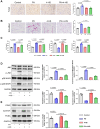4-hydroxysesamin protects rat with right ventricular failure due to pulmonary hypertension by inhibiting JNK/p38 MAPK signaling
- PMID: 38728253
- PMCID: PMC11131979
- DOI: 10.18632/aging.205808
4-hydroxysesamin protects rat with right ventricular failure due to pulmonary hypertension by inhibiting JNK/p38 MAPK signaling
Abstract
The specific mechanism of 4-hydroxysesamin (4-HS), a modification of Sesamin, on right ventricular failure due to pulmonary hypertension (PH) is ominous. By creating a rat model of PH in vivo and a model of pulmonary artery smooth muscle cell (PASMC) hypoxia and inflammation in vitro, the current work aimed to investigate in depth the molecular mechanism of the protective effect of 4-HS. In an in vitro model of hypoxia PASMC, changes in cell proliferation and inflammatory factors were detected after treatment with 4-HS, followed by changes in the JNK/p38 MAPK signaling pathway as detected by Western blot signaling pathway. The findings demonstrated that 4-HS was able to minimize PASMC cell death, block the JNK/p38 MAPK signaling pathway, and resist the promoting effect of hypoxia on PASMC cell proliferation. Following that, we found that 4-HS could both mitigate the right ventricular damage brought on by MCT and had a protective impact on rats Monocrotaline (MCT)-induced PH in in vivo investigations. The key finding of this study is that 4-HS may protect against PH by inhibiting the JNK/p38 MAPK signaling pathway.
Keywords: 4-hydroxysesamin; JNK/p38 MAPK signaling pathway; pulmonary hypertension; right ventricular failure.
Conflict of interest statement
Figures





References
-
- Kuan V, Denaxas S, Patalay P, Nitsch D, Mathur R, Gonzalez-Izquierdo A, Sofat R, Partridge L, Roberts A, Wong ICK, Hingorani M, Chaturvedi N, Hemingway H, Hingorani AD, and Multimorbidity Mechanism and Therapeutic Research Collaborative (MMTRC). Identifying and visualising multimorbidity and comorbidity patterns in patients in the English National Health Service: a population-based study. Lancet Digit Health. 2023; 5:e16–27. 10.1016/S2589-7500(22)00187-X - DOI - PubMed
MeSH terms
LinkOut - more resources
Full Text Sources
Medical
Research Materials

